
 | Go to the Archive index |
| Go to the Archive index |

Spotted at the Airship Run - 8 Sep 2013
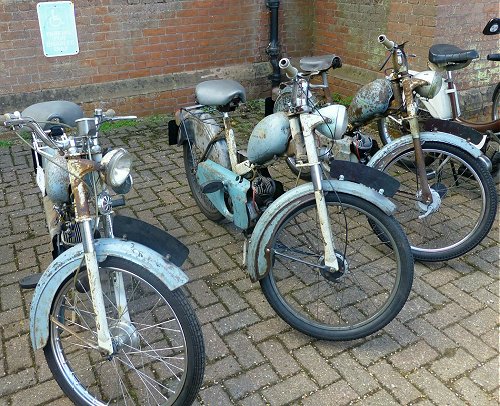
You don’t see a Hercules Corvette for ages—then
three turn up at once.
Of course, this didn’t happen by pure chance although
there was a certain amount of coincidence in there being three
Corvettes up & running, taxed & tested, and
available.
Getting three Corvettes to the start was one thing, getting
them all round the course was quite another. They all broke
down—one of them broke down twice—and none completed
the run under its own power.
However, the following weekend, all three were at the
Coprolite Run and, this time, all three were successfully ridden
all the way round the route.
Powered by a Lavalette engine and utilising several parts from
the Phillips Panda Plus, the Corvette was produced for less than
two years, being launched soon after the TI-Raleigh merger in 1960. It
ceased production in 1961 after the decision to replace all
TI’s moped ranges with licence-built Mobylettes.
First published in The
MAC in December 2013
>Spotted at Kneel’s Wheels - 17 Nov 2013
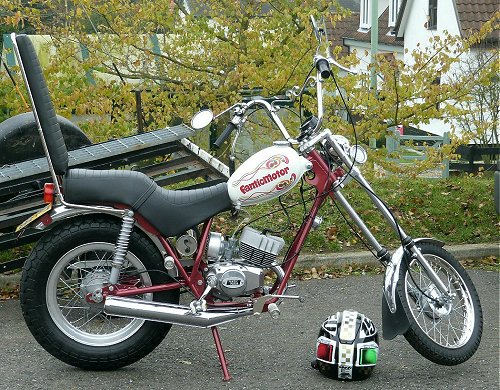
This one was the head-turner at our AGM run: a Fantic Chopper.
Fantic produced the Chopper in two sizes: 125cc and 50cc; this one, as you
can tell from the pedals, is the 50cc version.
This is a ‘sixteener special’: one of the machines
that the moped law was changed to outlaw n the 1970s. Being
under-50cc and with pedals made it legally a moped that could be
ridden at age sixteen. A contemporary road test
(Motorcycle Mechanics, December 1972)
reported that it was the most powerful moped they’d seen
and was capable of just over 50mph … or a bit more under the right
conditions.
This is Paul Kelling’s latest acquisition and he only
collected it a few days before Kneel’s Wheels. Not
surprising, therefore, that it suffered from a few teething
troubles on the run. What’s it like to ride with that
long fork? Paul’s own observations mirrored those in the
1972 test: ‘Handling came as a big surprise, simply because
it did … the roadholding proved better than many machines
of comparable performance. Manoeuverability too, wasn’t too
bad, considering the 57-inch, wheelbase.’
A teenager’s dream from the ’70s and, for most,
only a dream because very few teenagers would have been able to
afford one.
First published in The
MAC in December 2013
Spotted at the Mince Pie Run - 29 Dec 2013
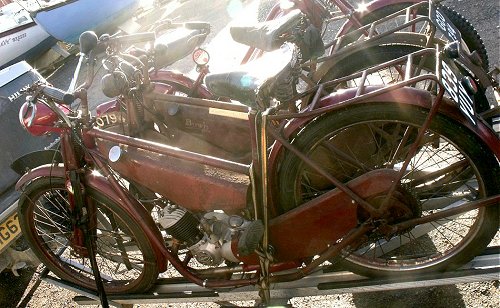
In the last issue we said ‘You don’t see a
Hercules Corvette for ages—then three turn up at
once’. Now we could say the same about Bown
autocycles at the Mince Pie Run. Not quite the same though
because we do often have a Bown at EACC runs.
Bown was an old-established cycle and motor cycle manufacturer
that became part of the Aberdale Cycle Company in the early
1930s. William A R Bown had a seat on
Aberdale’s board and was commissioned to produce a
replacement for the Aberdale autocycle for the 1949 season.
The replacement was needed because of the introduction of the
Villiers 2F engine and all makers of Villiers-powered
autocycles were redesigning their Junior de Luxe engined
machines to use the 2F.
Although scheduled to start production in March 1949, Aberdale
was provided with a factory at Llwynypia under the Labour
Government’s Advanced Factories Scheme, so introduction of
the new autocycle was delayed until the new factory was up and
running. This factory produced both autocycles and motor
cycles, which had originally been shown under the Aberdale name
at the 1948 Earls Court Show. February 1950 saw the
autocycle’s appearance on the market, branded as a Bown
product.
The new frame was unusually well engineered for an autocycle,
being a cradle type with duplex down tubes. Otherwise, the
Bown had all the usual features of the 2F ‘family’ of
autocycles: 4-inch hub brakes front & rear, Villiers lighting
set, lever operated throttle, strong rear carrier, rear stand and
pressed steel girder forks. Some more individual features
were inverted brake levers, a box silencer mounted between the
frame rails under the bottom bracket and a spring loaded jockey
wheel to tension the pedalling chain. The colour was maroon
with gold lining and its price (in March 1950) was
£58 15s 8d [£58.78], which included
£12 10s [£12.50] Purchase Tax.
The delay in getting the Bown into production was not good as
1950 was pretty much the beginning of the end for the autocycle
era; demand for this type of machine declined from then.
Even a reputation for being well-built machine couldn’t
stop Bown sales from declining along with nearly all other
autocycle makers. The autocycle ceased production and the
Welsh factory closed at the end of 1954.
That wasn’t the end for Bown: in November 1955 the name
re-appeared at the Earls Court Motor Cycle Show on a new
moped. The Aberdale Cycle Company also had a profitable
line in its Gresham Flyer children’s tricycles. In
1958, Aberdale was acquired by Tube Investments, mainly because
TI wanted to acquire the rights to the Gresham Flyer.
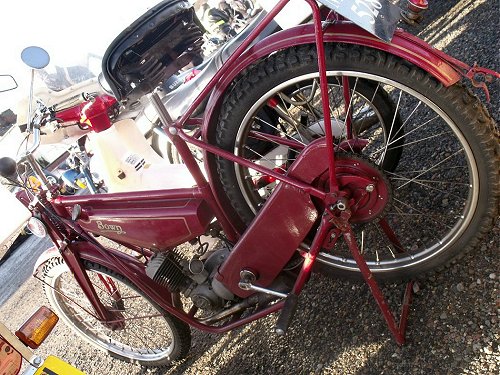
First published in The
MAC in March 2014
Spotted at the Mince Pie Run - 29 Dec 2013
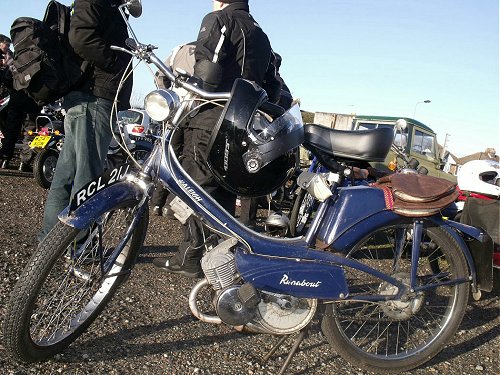
This is Barry Yallop’s Raleigh Runabout, a regular sight
at our runs in Suffolk.
The Raleigh Runabout RM6 was introduced in May 1963 at the
Blackpool Winter Gardens Show. The Runabout was based on
Motobécane’s Mobylette AV42.
Over the years, the Runabout became the mainstay of
Raleigh’s moped range. In addition to the standard
version, De Luxe and Super de Luxe variants were introduced,
along with the very basic ‘Pop’ model. Other
models in the Raleigh range, from the RM8 Automatic Mark II
to the RM12 Super 50 were all based around the Runabout
frame.
Barry’s RM6 dates from 1971, right at the end of
Raleigh’s moped production. By this time, the range
of Raleigh mopeds had dwindled until the standard Runabout was
the only one left.
The first Runabouts were finished in a two-colour scheme of
Raleigh Green and Pearl Grey. An all-over light blue
(Neptune Blue) colour scheme was adopted in 1965 while the
De Luxe models were painted Carmine Red. The
‘Pop’ was introduced in 1966 with its cheapness being
emphasised by it simple black colour.
Barry’s Runabout is finished in Royal Blue. This
darker blue colour was introduced in 1967 and lasted until the
end of production.
First published in The
MAC in March 2014
Spotted at the Radar Run - 13 Apr 2014
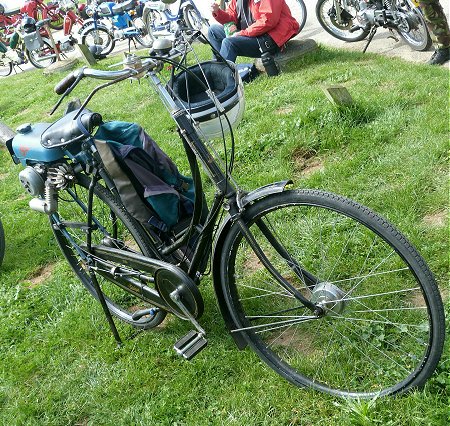
This machine attracted a good deal of attention at the Radar
Run, particularly from the bicycle enthusiasts.
Let’s start with the motor: it’s a Trojan
Mark 2 Mini-Motor dating from 1951.
Now the bit that attracted the attention of the bicycle fans:
a 1933 Special Raleigh. In the heyday of cyclemotors
UK purchasers could avoid
Purchase Tax by buying cycle and engine separately.
However, an even cheaper option was to just buy the engine unit
and fit it to a bicycle you already had. This meant that a
good many cyclemotors were mounted, like this one, on older
cycles.
The Special Raleigh was particularly suited as a cyclemotor
mount, being very well made and having drum brakes on both
wheels. The three-speed gear helps too: low gear is best
for starting the engine and the high gear mans you can give the
engine some LPA to
keep the revs up on inclines. A high-quality bike costing
10 guineas when new in 1933; in terms of average wages, that
works out around £2,500 in today’s money. If
you know your Raleighs, you’ll spot something odd about the
brake rods: the rear brake rod is beside the steering head
instead of in front. But that’s exactly what the 1933
catalogue shows for a drum-braked bicycle and seems to be
something Raleigh only did for a couple of years.
First published in The
MAC in June 2014
Spotted at the East Anglian Run - 18 May 2014
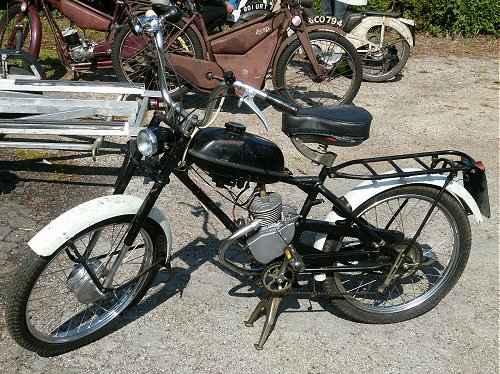
Our next bike is something quite different: A Red Star
Riga-413 dating from 1992. The 413 is a variant of the
Riga-13 model that was made from 1982. However, the basic
design dates back to 1966 and the Riga-5.
All these models of Riga were powered by Red October engines,
which were little more that a cyclemotor engine. The
Riga-13 models used the Red October D8 series of engines and the
413 has a D8e.
Broadly speaking, the Latvian Red Star factory produce two
kinds of moped. Riga-5, 7, 11, and 13 were basic,
single-speed machines that were little better than
cyclemotors. The others were more like ‘proper’
mopeds, using a two-speed engine with built in pedals (or
kick-start on the later models).
The dissolution of the Soviet Union in 1991 heralded the end
for Riga mopeds. The factory closed in 1998 but moped
production had already dwindled to nothing several years before
that.
This Riga was at the run for inspection and dating so,
although it didn’t go along on this run, we may see it in
action soon.
First published in The
MAC in June 2014









